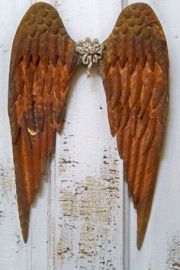All metals other than precious metals rust when exposed to an electrolyte (i.e. atmospheric moisture) and oxygen. Rusting is caused by the chemical reaction of the metal surface and the oxygen present in the air and form the respective metal oxide on the surface. In steel, the corrosion products formed are quite visible and are loose. You must have seen the red color of iron oxide on unprotected steel products. This red rust is scaly and loose and easily falls away thus exposing more portion of the metal to rust. Metals like stainless steel also rusts however, the nickel and chromium oxides formed are a more uniform and tenacious oxide layer that save the metal by sealing the surface from further rusting.
When a metal is kept indoors, moisture above about 65% relative humidity is required to rust iron. However, the contamination of salt, dust or other pollutants may cause rusting at lower humidity level. At higher humidity level contamination of pollutants will accelerate further rusting of underlying metal. The presence of salt or oil on the surface of metals creates the kind of rusting environment that causes metals to reacts. Exposure of metals to cooking materials enhances the rusting rate.
Effects of rusting on Metal
Metals have the tendency to return to their natural state and this is the primary cause of the rusting. One a metal has rusted, it loses its strength. To prevent from a metal from rusting various methods are implemented such as painting, bluing, galvanization, and other forms of protection. Rust causes millions of dollars of damage every year and billions of dollars are spent to repair the damage, or to inhibit it thus adding extra expenditures for the maintenance of the metal.
Rusting can be easily prevented. All the metals are not prone to rust. Using preventive measures like painting, bluing and galvanization can prevent metals from rusting.
Related articles
- Preventing Corrosion of Metals (rustfreemetal.wordpress.com)
